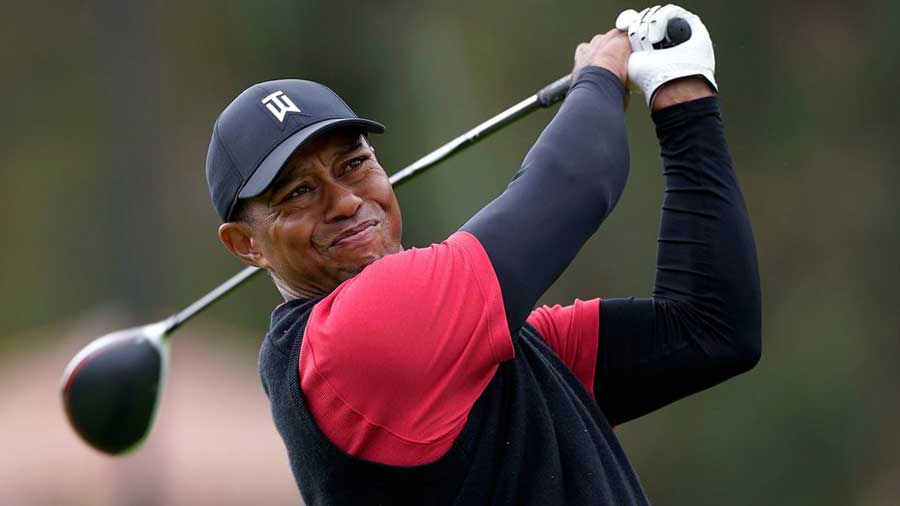The serious lower leg injuries Tiger Woods sustained in a car crash on Tuesday typically lead to a long and perilous recovery with the jury out among medical experts on when he could again play competitive golf.
Already credited with one of sport’s great comebacks when he returned from back surgery to win a fifth Masters in 2019, ending an 11-year majors drought, Woods will have to be even more resilient if he is to overcome the damage done in Tuesday’s accident, according to orthopaedic surgeons who have treated similar injuries.
In the accident near Los Angeles, Woods’s lower right leg was smashed and his right foot severely injured, and his leg muscles swelled so much that surgeons had to cut open the tissue covering them to relieve pressure, Dr. Anish Mahajan, the chief medical officer at Harbor-U.C.L.A. Medical Center, where Woods, 45, was treated, wrote in a Twitter message posted on Woods’s account.
Doctors also inserted a rod into Woods’s shin bone, and screws and pins into his foot and ankle.
Physicians familiar with these kinds of injuries described the complications they typically bring.
The crash caused a cascade of injuries. It smashed Woods’s shin bones, with primary breaks in the top and bottom parts of the bones and a scattering of bone fragments. When the bones in Woods’s shin shattered, they damaged muscles and tendons; pieces poked from his skin.
The trauma caused bleeding and swelling in his leg, threatening his muscles. Surgeons had to quickly cut into the layer of thick tissue covering his leg muscles to relieve the swelling. Had they not, the tissue that covers swelling muscle would have acted like a tourniquet, constricting blood flow. The muscle can die within four to six hours.
It is possible that some muscle died anyway, between the accident and the surgery, said Dr. R. Malcolm Smith, the chief of orthopaedic trauma at UMass Memorial Medical Center in Worcester, Massachusetts. “Once you lose it, you cannot get it back,” he said.
Add to that the risk of infections and the risk of fractures that do not heal or that grow together only very slowly. “To get things to heal, you need good blood flow,” said Dr. Reza Firoozabadi, an orthopaedic trauma surgeon at Harborview Medical Center in Seattle. “With an injury like this, blood flow is disrupted.”
As a result, he said, it may take five to 14 months for Woods’s lower leg bones to grow together, assuming they do so at all.
The biggest hurdle will be his foot and ankle injuries, Firoozabadi and other doctors said. Regaining range of motion and strength can take three months to a year. Depending on the extent of those injuries, even after rehabilitation, Woods may barely be able to walk.
His rehabilitation may be complicated by back surgery in December. Woods also has gone to rehabilitation for an addiction to painkillers; pain management during his recovery now may be difficult.
But minus any major complications, it is possible Woods could be ready to tee it up at next year’s Masters, said Dr Riley Williams, sports medicine surgeon at New York’s Hospital for Special Surgery.
“He has the right psychological makeup and obviously very focused and driven,” said Williams, who operated on and managed NBA player Paul George’s compound fracture in 2014. “Let’s assume in the most straightforward case we’ve got good bone healing by 12 weeks and then another three months of general recovery.
“I could see him being on the range 6-to-12 months after surgery,” he said.
“The Masters next year is certainly within reason, again barring some unknown complicating factors.”
Dr Nicholas DiNubile, spokesman for the American Academy of Orthopedic Surgeons, said elite athletes possess all the tools to deal with such adversity, but that in this case, since Woods is 45, the question is whether he will want to go through the grind one more time.
“This is as serious as it gets when you have an open fracture because of the risk of infection,” DiNubile told Reuters. “Tiger Woods, of everything I have read about him, is a really tough guy. He has been through a lot injuries.
“He used to train with the Navy Seals and it sounds like even at the scene of the accident he was trying to get out of the car on his own,” he said.
“I wouldn’t (write him off). The thing against him is his age and at this point in his career does he need to do that?”











